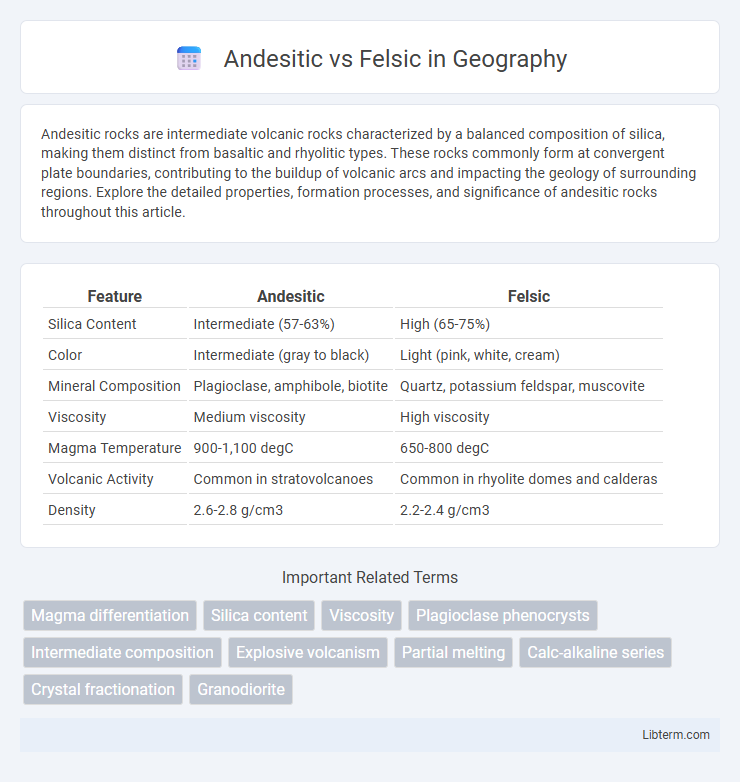Andesitic rocks are intermediate volcanic rocks characterized by a balanced composition of silica, making them distinct from basaltic and rhyolitic types. These rocks commonly form at convergent plate boundaries, contributing to the buildup of volcanic arcs and impacting the geology of surrounding regions. Explore the detailed properties, formation processes, and significance of andesitic rocks throughout this article.
Table of Comparison
| Feature | Andesitic | Felsic |
|---|---|---|
| Silica Content | Intermediate (57-63%) | High (65-75%) |
| Color | Intermediate (gray to black) | Light (pink, white, cream) |
| Mineral Composition | Plagioclase, amphibole, biotite | Quartz, potassium feldspar, muscovite |
| Viscosity | Medium viscosity | High viscosity |
| Magma Temperature | 900-1,100 degC | 650-800 degC |
| Volcanic Activity | Common in stratovolcanoes | Common in rhyolite domes and calderas |
| Density | 2.6-2.8 g/cm3 | 2.2-2.4 g/cm3 |
Introduction to Andesitic and Felsic Rocks
Andesitic rocks are intermediate volcanic rocks characterized by moderate silica content, typically ranging from 57% to 63%, and are commonly found in volcanic arcs associated with subduction zones. Felsic rocks, such as granite and rhyolite, have high silica content above 65%, leading to lighter mineral compositions dominated by quartz and feldspar. These compositional differences influence their texture, color, and eruption style, with andesitic rocks being darker and more viscous compared to the lighter and more explosive felsic rocks.
Definition and Key Characteristics
Andesitic rocks are intermediate volcanic igneous rocks with moderate silica content (57-63%) and a composition between mafic and felsic types, typically containing plagioclase feldspar and amphibole minerals. Felsic rocks have high silica content (above 65%), characterized by light-colored minerals such as quartz and potassium feldspar, resulting in lower density and higher viscosity magma. Andesitic compositions are commonly associated with volcanic arcs and subduction zones, while felsic rocks often form continental crust and are linked with explosive volcanic eruptions.
Mineral Composition Comparison
Andesitic rocks primarily consist of plagioclase feldspar, amphibole, and pyroxene, with moderate silica content ranging from 57% to 63%. Felsic rocks are rich in quartz and potassium feldspar, featuring higher silica content above 65%, which results in lighter minerals and more explosive volcanic activity. The mineral composition differences drive distinct textures and chemical properties, influencing volcanic behavior and rock formation processes.
Formation Processes
Andesitic rocks form primarily through the partial melting of oceanic crust and mantle materials at convergent plate boundaries, leading to intermediate silica content and volcanic activity in subduction zones. Felsic rocks originate from the extensive crystallization of magma enriched in silica, often linked to continental crust melting and magmatic differentiation processes resulting in granite and rhyolite formations. These distinct formation processes influence their mineral composition, with andesitic rocks containing plagioclase and amphibole, while felsic rocks are rich in quartz and orthoclase feldspar.
Color and Texture Differences
Andesitic rocks typically display a medium-gray to greenish-gray color with a fine to medium-grained texture, often containing visible plagioclase and amphibole minerals. Felsic rocks, such as granite or rhyolite, exhibit lighter colors ranging from white and pink to light gray, with a coarse-grained texture dominated by quartz and potassium feldspar. The distinct mineral composition directly influences the contrasting color and texture between andesitic and felsic rocks, reflecting their different silica content and cooling histories.
Geographic Distribution
Andesitic rocks predominantly form along convergent plate boundaries, especially in volcanic arcs of the Pacific Ring of Fire, such as the Andes Mountains and the Cascades in North America. Felsic rocks, rich in silica, are primarily found in continental crust regions, including large intrusions like the Sierra Nevada batholith in California and the continental shields of North America and Australia. The geographic distribution highlights the tectonic settings where andesitic composition reflects subduction zone volcanism, while felsic rocks are associated with continental crust formation and evolution.
Volcanic Activity and Eruption Styles
Andesitic magma, typically found in subduction zones, has intermediate silica content (57-63%) resulting in moderate viscosity that produces explosive eruptions and the formation of stratovolcanoes. Felsic magma, rich in silica (over 65%), is highly viscous, trapping gases and causing highly explosive eruptions with pyroclastic flows and ash columns, often forming calderas. The eruption styles of andesitic volcanoes tend to be less violent but more frequent, while felsic eruptions are rarer but significantly more violent and destructive.
Economic and Industrial Uses
Andesitic rocks, rich in intermediate minerals, are commonly utilized in construction due to their hardness and durability, making them suitable for road base materials and aggregates in civil engineering projects. Felsic rocks, characterized by high silica content and minerals such as quartz and feldspar, are valued for producing high-quality ceramics, glass, and as decorative stone in architectural applications. Both rock types also serve as important sources of industrial minerals, with felsic formations more frequently associated with rare metal deposits like lithium and tantalum critical for electronics and renewable energy technologies.
Identification in the Field
Andesitic rocks display a medium gray to dark color with intermediate silica content and often contain visible plagioclase feldspar and amphibole minerals, aiding field identification. Felsic rocks are typically lighter in color, ranging from white to pink, with higher silica content and abundant quartz and potassium feldspar crystals visibly distinguishable in hand samples. Texture and mineral composition are key for differentiating andesitic from felsic rocks during geological fieldwork.
Summary and Key Distinctions
Andesitic and felsic rocks differ primarily in silica content and mineral composition, with andesitic rocks containing intermediate silica levels (57-63%) and a mix of plagioclase and amphibole minerals, while felsic rocks have higher silica content (above 65%) dominated by quartz and potassium feldspar. Andesitic rocks typically form in volcanic arcs associated with subduction zones, exhibiting intermediate viscosity and eruption explosivity compared to the more viscous and explosive felsic rocks. These distinctions influence their geological settings, eruption styles, and the resulting rock textures and mineralogy.
Andesitic Infographic

 libterm.com
libterm.com